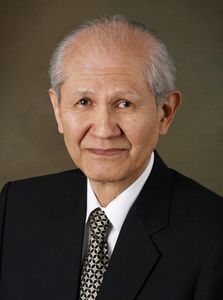Osamu Shimomura to Be Honored at Commencement Nobel-winning chemist will receive Doctor of Science
Osamu Shimomura, a Nobel Prize–winning chemist and a School of Medicine professor emeritus of physiology, will be awarded an honorary Doctor of Science at the Boston University’s 137th Commencement ceremonies on Sunday, May 16, 2010.
Shimomura, a former senior scientist at the Marine Biological Laboratory in Woods Hole, Mass., was one of three winners of the prize in 2008 for his discovery of green fluorescent protein in the jellyfish Aequorea victoria. He shared the $1.4 million award with Martin Chalfie of Columbia University and Roger Y. Tsien of the University of California, San Diego, two researchers who pioneered cellular research techniques using the proteins Shimomura identified.
Shimomura found the GFP in the jellyfish, located off the west coast of North America, in 1962. James Head, a MED professor of physiology and biophysics, recalls Shimomura’s stories of collecting the jellyfish — Shimomura began his research with 10,000 specimens — in Washington state.

“He and his wife used to spend summers at Friday Harbor and catch bucket after bucket of jellyfish,” says Head, who collaborated with Shimomura on research into the behaviors and uses of aequorin, another fluorescent protein. “In those early days, he would purify the protein directly from the jellyfish, getting small amounts of protein from bucketfuls.”
But although Shimomura pursued his studies of GFP for years, he didn’t realize the potential applications of his work until 1994, when Chalfie’s research emerged. In an organism, GFP can be fused to proteins of interest to scientists, with minor effects on the organism’s behavior. Researchers can then observe the locations and movements of the studied proteins by monitoring the GFP, which remains fluorescent.
“This protein has become one of the most important tools used in contemporary bioscience,” according to the announcement of the Nobel Prize by the Royal Swedish Academy of Sciences. “With the aid of GFP, researchers have developed ways to watch processes that were previously invisible, such as the development of nerve cells in the brain or how cancer cells spread.”
“These discoveries were seminal and decades ahead of their time,” says Gary Borisy, director and CEO of the Marine Biological Laboratory. “They really have ushered in a revolution in cell biology.”
Shimomura, who earned a Ph.D. in organic chemistry at Nagoya University in 1960 and began studying bioluminescence there before coming to America and joining a research team at Princeton University, says he never expected his work to change the world of cell biology.
Shimomura is one of five honorary degree recipients at this year’s Commencement. Playwright Edward Albee will be awarded a Doctor of Letters. Attorney William T. Coleman, Jr., a champion of civil rights, will receive a Doctor of Laws. Wafaa El-Sadr, a pioneering AIDS researcher, will be presented with a Doctor of Science. Commencement speaker Eric H. Holder, Jr., attorney general of the United States, will receive a Doctor of Laws.